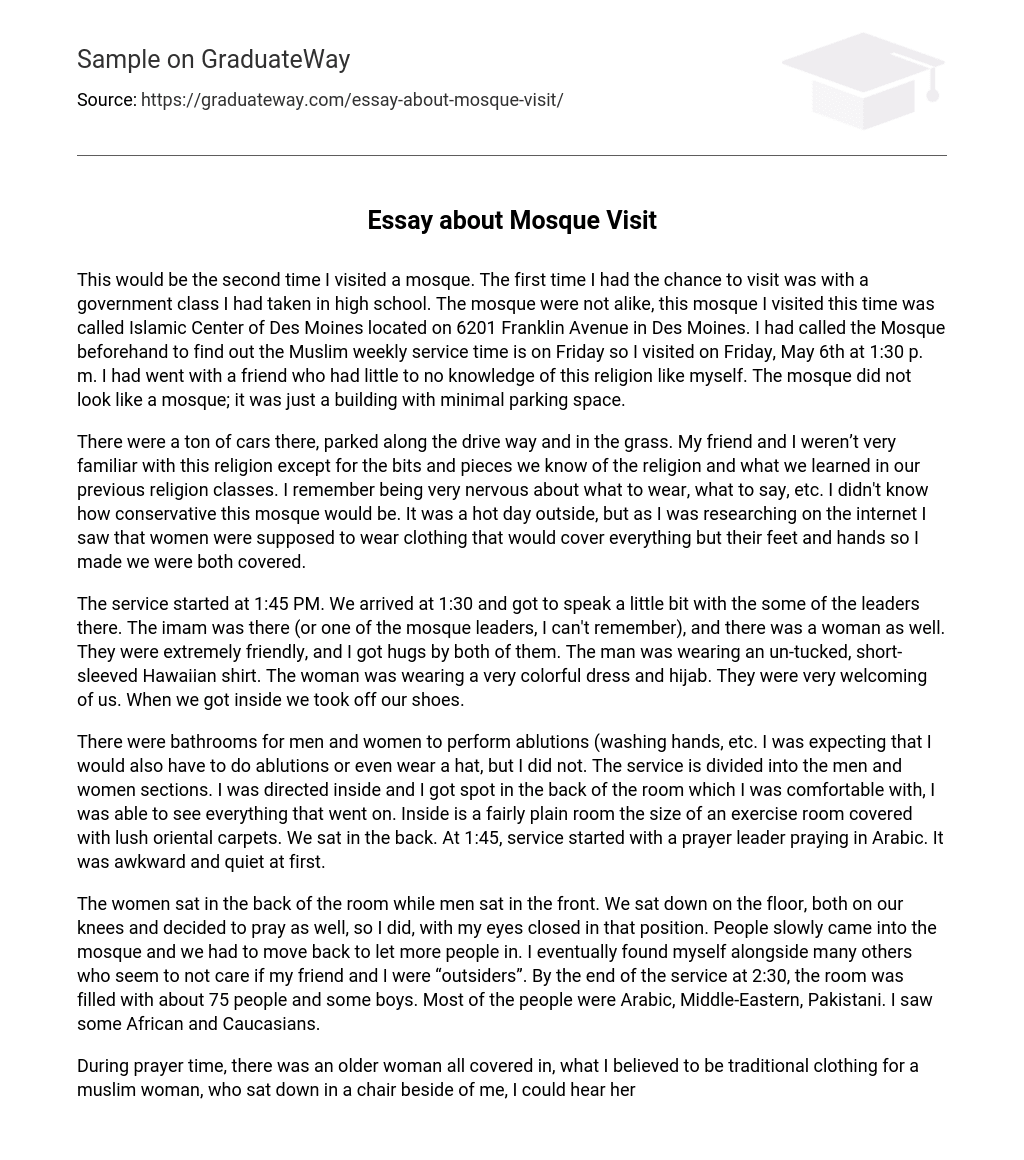On my second visit to a mosque, I had the opportunity to explore the Islamic Center of Des Moines at 6201 Franklin Avenue in Des Moines. This mosque differed from the one I previously visited during a government class in high school, especially in terms of its appearance. To make sure that I attended the weekly Muslim service, I called ahead and found out that it was held on Fridays. On May 6th at 1:30 p.m., accompanied by a friend who also had limited knowledge about Islam, I arrived at the mosque. Interestingly, the mosque seemed like a modest building with limited parking space.
There was a large gathering at the mosque, evident from the many cars parked on the driveway and in the grass. Although my friend and I had limited knowledge about this religion, we had some understanding from previous religion classes. The thought of going to the mosque made me feel anxious because I wasn’t sure what attire and words were appropriate. To alleviate my concerns, I went online to research and discovered that women were expected to dress modestly, covering everything except their feet and hands. To ensure compliance with this requirement, I ensured both of us were appropriately covered.
The service at the mosque started at 1:45 PM. When we arrived at 1:30, we had a brief conversation with some of the leaders, either the imam or one of them. A woman was also there with them. Both people were very friendly and even hugged me. The man was wearing an untucked Hawaiian shirt with short sleeves, while the woman wore a colorful dress along with a hijab. They warmly welcomed us, and when we entered the mosque, we removed our shoes.
Both genders had separate bathrooms for performing ablutions like handwashing, etc. I anticipated needing to do these ablutions or wear a hat, but it turned out that neither was necessary. The service was divided into male and female sections. Upon being directed inside, I located a comfortable spot at the rear of the room where I had a clear view of everything happening. The room itself was quite simple, comparable in size to a gymnasium but adorned with exquisite oriental carpets. We opted to sit towards the back. The service began at 1:45 when an Arabic-speaking prayer leader commenced offering prayers, resulting in an initially uncomfortable and quiet atmosphere.
The room was divided, with women positioned at the back and men at the front. All of us sat on our knees on the floor and began praying, closing our eyes as we joined in. As more people arrived at the mosque, we made space for them. Eventually, my friend and I found ourselves among others who recognized that we were “outsiders”. By the end of the 2:30 service, approximately 75 individuals, including boys, filled up the room. The attendees mainly comprised Arabic, Middle-Eastern or Pakistani individuals; however, there were also Africans and Caucasians in attendance.
While praying, an elderly woman wearing what I assumed was traditional Muslim clothing sat next to me. Her prayer reminded me of the soft speaking in tongues my childhood pastor would do when praying for others. This familiarized the mosque for me. No music or other noises were audible. Eventually, the pastor came forward to give a speech. A hush fell over the room, as I later found out that only the Imam was allowed to speak during this time.
The imam emphasized the significance of religious freedom, noting its absence in other countries, including Islamic nations. However, he offered a distinct viewpoint on the separation of Church and State by highlighting the presence of “In God we trust” on our currency, indicating that religion and government are not entirely separate. Additionally, he drew a parallel between our tax obligations and the taxation system in ancient Muslim caliphates, where non-believers were subjected to higher taxes. This historical context illustrates that individuals were less pressured to convert to Islam in other countries due to Muslims’ economic advantage.
Although I initially didn’t believe the comparison, I later discovered that sharia carries significant importance for many Muslims. However, the interpretations and principles of sharia (the way/path followed by Muslim people) vary just as much as Christian beliefs. This religious gathering didn’t include any formalities like communion. The service concluded with a few announcements. A distinct prayer specifically for Muslims followed the service, emphasizing that non-Muslims should remain seated in the chairs at the sides of the primary worship area. The prayers were conducted in Arabic and recited collectively.
Following the service, I was greeted with numerous handshakes and expressions of appreciation for my attendance. Furthermore, a donation basket was positioned in the lobby, mirroring the practice at my former church where tithes were not requested or offering plates passed around. Additionally, there was an option to purchase boxed lunches priced at $5 after the service, which consisted of delectable Pakistani rice and chicken. Many individuals opted to take a box and depart, while only a small group lingered to engage in conversation with others. The parking lot posed challenges due to the substantial number of cars present; however, this did not detract from the overall experience.





